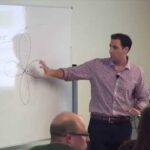|
|

Matt Silverman presented for Cisco and Cisco Mobility at WFD7 |

This video is part of the appearance, “Cisco Presents at Wireless Field Day 7“. It was recorded as part of Wireless Field Day 7 at 9:30-11:30 on August 8, 2014.
Watch on YouTube
Watch on Vimeo
In the Tech Field Day presentation titled “Cisco MU-MIMO Deep Dive,” Matt Silverman, a Technical Leader at Cisco, provides an in-depth exploration of MIMO technology, focusing on the transition from single-user MIMO (SU-MIMO) to multi-user MIMO (MU-MIMO). Silverman begins by explaining the basics of SU-MIMO, which has been a part of the 802.11 standards since the ABG iterations. SU-MIMO allows for the transmission of multiple spatial streams to a single client, thereby increasing throughput and capacity. However, this requires multiple antennas on both the access point (AP) and the client. The introduction of 11n and 11ac standards has enabled higher data rates, but the presence of lower data rate clients, such as those with one or two antennas, can still drag down overall network performance.
Silverman then delves into the mechanics of MU-MIMO, which aims to enhance overall network capacity by transmitting different spatial streams to multiple clients simultaneously. This approach is particularly beneficial in environments with a mix of high and low data rate clients. By sending one spatial stream to each client, MU-MIMO can optimize the use of available bandwidth and reduce contention events, which occur when multiple devices compete for access to the wireless medium. Silverman explains that the AP must perform complex beamforming and nulling techniques to ensure that each client receives its intended spatial stream without interference from others. This involves sophisticated channel sounding protocols, where the AP periodically sends out frames to measure the channel conditions and adjust its transmission strategy accordingly.
The presentation also addresses the challenges of implementing MU-MIMO, such as the need for frequent channel sounding and the difficulty of maintaining accurate beamforming in dynamic environments. Clients that are mobile or located at the edge of the cell may require more frequent channel updates, which can introduce overhead and reduce the efficiency of MU-MIMO. Silverman emphasizes the importance of intelligent scheduling and firmware that can dynamically decide whether to use SU or MU-MIMO based on current network conditions. He also notes that while MU-MIMO can significantly improve performance in high-density environments like stadiums, it is not a one-size-fits-all solution and must be carefully integrated into the overall network design.
Personnel: Matt Silverman










